These articles originally appeared in “Orders of the Daye”,
the magazine of the The Sealed Knot
Index
- Decorating Unconfined Breeches
- Tacking
- How to make Small Slashes in fine fabric
- Making Stays
- Organ or Cartridge Pleating
- Types of Boning
- Stiffening a Doublet
- Making a Toile
I have tried to aim the tips at inexperienced sewers so some readers may think I am re-inventing the wheel.
An important point to make is that although tedious, preparation & neatness before, during & after construction produces a better final garment.
I make no apology for using imperial measurements i.e. inches. I also give only approximate measurements. I am writing guidelines not rules. Good luck with any sewing you decide to do.
If you have any tips that you would like included contact me and I’ll see what I can do
Decorating Unconfined Breeches
| One tip given to me by a tailor friend, sadly no longer with us. When decorating unconfined breeches with ribbons and metal points, leave a gap of 2-4 inches on the inside leg. The gap will not be very noticeable but the wearer will be able to walk without the points getting tangled up. Like many tips it is obvious after you have been told. | 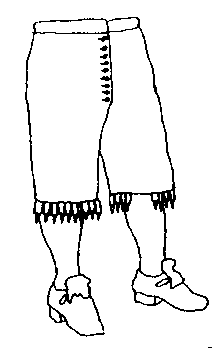 |
Tacking
| I rarely tack but do use long pins (1″ inch) when sewing. If I want to hold pieces of fabric together during sewing I pin at 90ø to the fabric edge, so that I can easily sew over them – be careful & do expect some broken machine needles when using this technique. |
How to make small slashes in fine fabric.
| In the 17th Century small slashes were made by sizing the back of silk satin often by painting the fabric with gum arabic. Allowing it to dry. Then stretching fabric tight and stamping the pattern with a sharp metal shape , not unlike a small printing block.I have not tried this but I doubt if it would work on thick woollen fabric. | 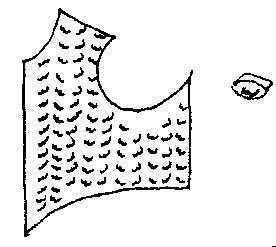 |
Making Stays.
| When fitting stays remember that the lady’s bustline will be different to her 20th century shape.
A rough guideline is to take 2 inches off her normal bust measurement to compensate. For more advice on fitting stays I suggest reading “Period Costume for Stage and Screen” by Jean Hunnisett. Also see try my article on Making Stays. |
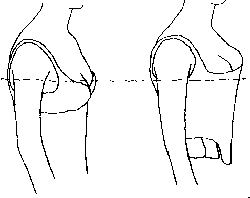 |
Cartridge or Organ Pleating.
This method of pleating is very old and can be seen in contemporary, i.e.. 17th century, paintings. Sew the widths of fabric together. Turn the top edge down approximately 2 inches, I tend to fold top edge over twice for neatness and a firmer finish.
| Using 2 separate needles stitch along the folded portion approximately 1 inch stitches 1 inch apart. Gather the stitches together, i.e.. Pull the threads, and arrange neatly to match the size of the waistband. Catch stitch the gathers onto the waistband, right sides together. This means the sides of the fabric which will be seen on the outside of the finished skirt. When using this method of pleating I strongly recommend leaving a gap in pleating over your tummy otherwise you will be asked delicate questions about pregnancy ! |
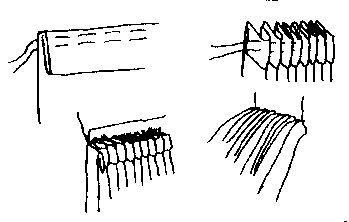 |
You can finish the inside of the skirt by knotting the big stitch threads together. You can also stitch the inside gathers together to help hold the shape.
Types of Boning
Steel Boning:
Bought by the yard or metre, can be difficult to cut. Use ridgeline endcaps to cover cut ends Very firm boning.
To sew use 2 layers of fabric e.g.. cotton calico, sew channels and slot boning in place. Interlining, the layers of fabric inside the outer fabric and lining holding the boning, needs to be cut slightly smaller than outer fabric and lining.
Plastic Boning:
Brand name ridgeline. Bought by the yard or metre. Easy to cut with dressmaking scissors. Cover ends with ridgeline endcaps or melt ends over a flame – in a well ventilated room (Be careful). Can be sewn directly onto inside of lining fabric or onto interlining.
Bamboo Barbecue Skewers:
Approximately 12 inches long, Can be cut with a sharp knife, be careful. Like steel boning use 2 layers of interlining fabric and sew channels to slot bamboo in.
These are useful to give a very firm edge centre front or centre back between edge and lacing holes.
If you have a bodice which has no boning you can bone pieces of calico and attach the boned calico to the inside of the bodice to produce a neat finish.
Stiffening a Doublet:
| 17th Century doublets were often stiffened with buckrum. The collar and belly pieces were stiffened.You can also use iron on interlining down the centre front of the doublet and in the tabs to produce a very professional finish – do this as well as using buckrum for stand-up collar and belly pieces – not instead of (or the authentic crowd will lynch me!) | 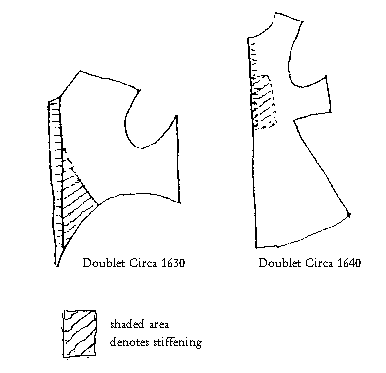 |
Toile:
When using a pattern for the first time it is useful to make a Toile. Cut the pattern out using an inexpensive fabric such as calico. Allow at least 1 inch for seam allowances and draw around the pattern to give an initial sewing line, machine sew using large stiches.
Try the garment on to see if it fits properly. Any adjustments can be tried out first using the Toile.
The Toile can be used as pattern pieces for your main fabric. If it is not too untidy or cut-up you can use it to line the main garment.
